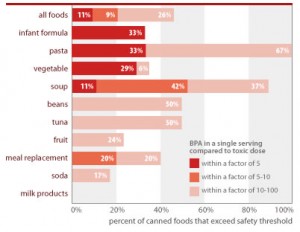I do hope you’ve heard of BPA, and how it’s a shady component in many of our food containers.
I was shocked when a nurse at my OB’s office was unfamiliar with the concerns about BPA in baby bottles. I thought it was practically a mainstream scare, not just something us weirdo-hippy types talk about.
BPA is bisphenol-A, a chemical commonly used in food and beverage containers. Plastic seems to be the best known source of BPA in our food, though the ingredient is also used in the lining of aluminum cans holding soups, fruits and vegetables, meats and pastas.
Yup. Put down that bottled water and tuna sandwich. Why do they have to make it so hard to be healthy safely?
I’ve known about BPA for quite a while now, and have tried to minimize it in our home as much as possible – especially now that I’m pregnant. There are suspicions that developing fetuses are particularly vulnerable to the effects of BPA. I got one heck of a reminder about this from Michigan Radio yesterday.
According Joe Braun, a research fellow at the Harvard School of Public Health, a recent study found that “…gestational bisphenol-A exposures… were associated with behavior problems with the girls of these mothers at three years of age.” He suggests that the reasons for this could be related to the fact that BPA acts like an estrogen, and may interfere with fetal brain development. The same effects were not seen in boys, and the study took into account other factors, such as smoking and socio-economic class.
Now, I can think of far worse things than behavioral issues when it comes to potential negative effects of chemicals in our food supply. Still the fact that BPA seems to interfere with brain development of unborn people sends up a huge red flag, suggesting that there’s more to it.
A quick online search brought up a 2007 article from the Environmental Working Group. Here are the points that stood out to me:
- “There are no government safety standards limiting the amount of BPA in canned food.” (although this may have changed since then – trying to decipher the FDA’s own page on that)
- “Of all foods tested, chicken soup, infant formula, and ravioli had BPA levels of highest concern. Just one to three servings of foods with these concentrations could expose a woman or child to BPA at levels that caused serious adverse effects in animal tests.”
- “For 1 in 10 cans of all food tested, and 1 in 3 cans of infant formula, a single serving contained enough BPA to expose a woman or infant to BPA levels more than 200 times the government’s traditional safe level of exposure for industrial chemicals.”
- “More than 100 peer-reviewed studies have found BPA to be toxic at low doses…”
- “FDA estimates that 17% of the U.S. diet comprises canned food…”
- “BPA is associated with a number of health problems and diseases that are on the rise in the U.S. population, including breast and prostate cancer and infertility.”
- “Among the foods we tested are 20 of the 40 canned foods most commonly consumed by women of childbearing age (NHANES, 2002), including soda, canned tuna, peaches, pineapples, green beans, corn, and tomato and chicken noodle soups. We also tested canned infant formula. The lab detected BPA in fifty-seven percent of all cans.”
- “In studies conducted over the past 20 years, scientists have detected BPA in breast milk, serum, saliva, urine, amniotic fluid, and cord blood from at least 2,200 people in Europe, North America, and Asia (CERHR 2006). Researchers at the Centers for Disease Control and Prevention recently detected BPA in 95% of nearly 400 U.S. adults (Calafat et al. 2005).”
- “At some of the very lowest doses the chemical causes permanent alterations of breast and prostate cells that precede cancer, insulin resistance (a hallmark trait of Type II diabetes), and chromosomal damage linked to recurrent miscarriage and a wide range of birth defects including Down’s syndrome (vom Saal and Hughes 2005).”
- “The U.S. National Toxicology Program’s 2001 assessment, which found BPA safe at low doses, relied heavily on industry-sponsored studies showing no low-dose BPA effects (NTP 2001).”
- “Companies began using BPA in metal can linings in the 1950s and 1960s (Schaefer and Simat 2004), fully twenty years after the chemical was first understood to be toxic (Dodds and Lawson, 1936 and 1938).”
There’s plenty more to damn BPA, but I’ll let you read it for yourselves. Astounding stuff.
For the time being, me and the Grumpy Apple/Mini Pumpkin are staying away as much as we can.
Sources:
http://www.ewg.org/reports/bisphenola
http://www.fda.gov/NewsEvents/PublicHealthFocus/ucm197739.htm#current

